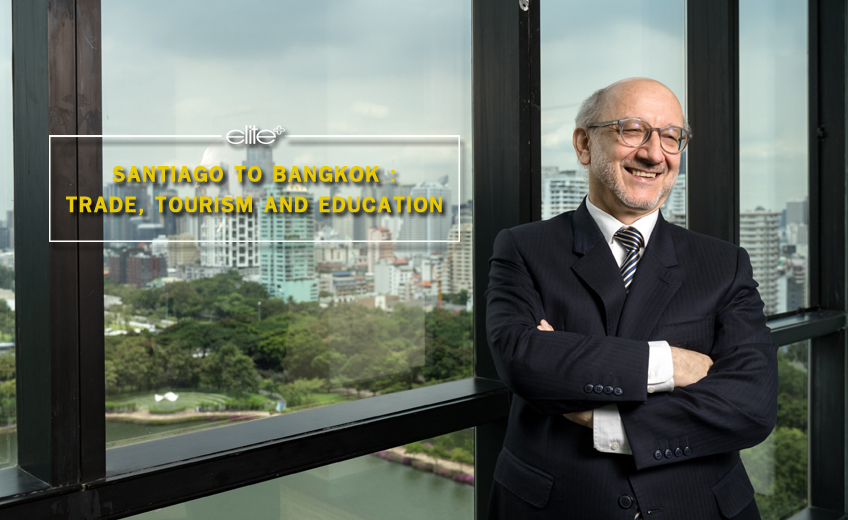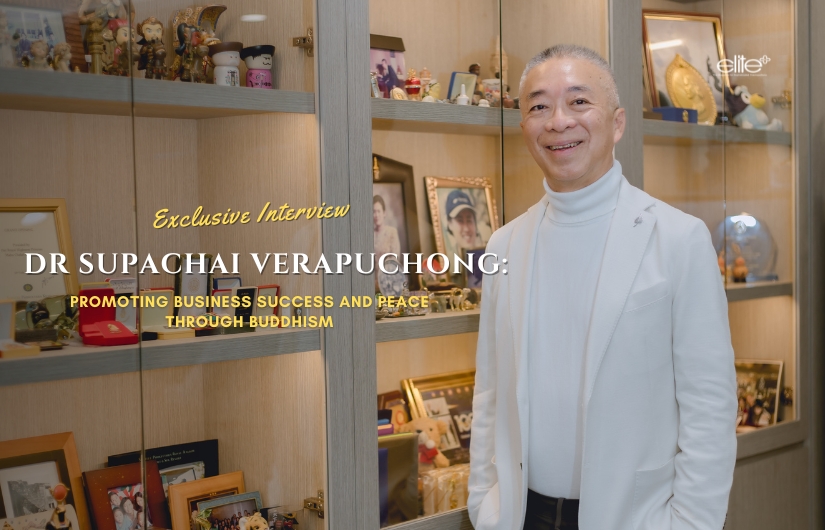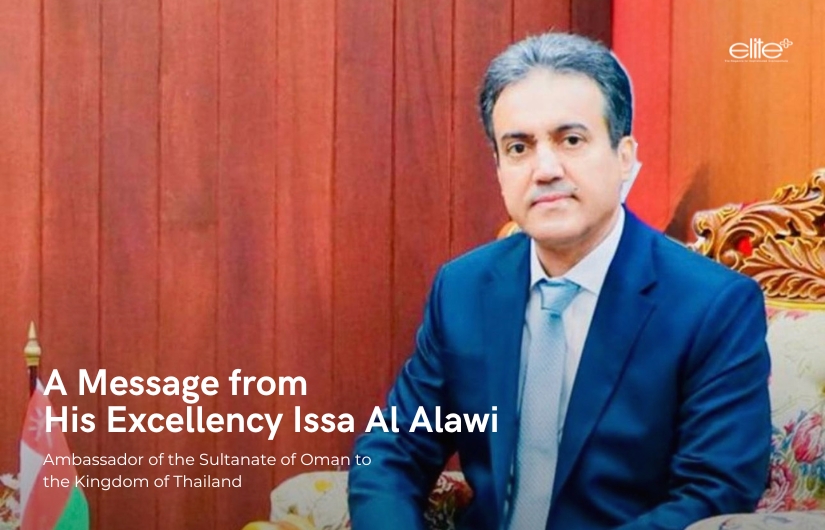It is not the new Chilean Ambassador to Thailand’s first posting in Asia; Christian Rehren Bargetto has previously worked as a diplomat in Japan and Malaysia, as well as in embassies around the world from Ecuador to Romania. But four months into his new gig heading up bilateral relations between Santiago and Bangkok, this is proving to be one of the seasoned envoy’s greatest opportunities to make an impact.
Chile and Thailand have only had official ties for 55 years – young in terms of international diplomacy – but that relationship is stronger than it has ever been. Thanks to a free trade agreement signed last year and cooperation within the Association of Southeast Asian Nations (ASEAN), Thailand is an increasingly influential market for Chile and vice versa, despite being situated on opposite sides of the Pacific, in opposite hemispheres.
Thailand is the number one tourist destination for Chileans, and in the first six months of 2017 Thailand was among the top 10 importers to Chile, ranking behind usual suspects such as China, the US and Japan. There is great potential for economic growth and even stronger ties between Thailand and Chile.
Ambassador Rehren has made it his mission to increase trade and spur more interest in and knowledge about his narrowly shaped South American country with its fascinating, diverse topography that includes the iconic Andes mountains, its thriving arts and literature scene and appealing food exports such as wine, seafood, nuts and various fruits. Elite+ sat down with Ambassador Rehren to discuss the Thai-Chilean relationship and his plans for improving areas such as bilateral trade, tourism and education
- How have your first few months been?
I’m very pleased, settling in very quickly. I took advantage of May, June and July, months that everyone is busy in other things, so it has been very interesting and challenging. I’ve been meeting lots of officials, academics, private sector individuals and so on. I said to myself in the first 90 days I should try to have an advanced picture of what I will be engaged with.
- You asked to be assigned here. Why?
There is no one sole reason, but personal and working reasons, let’s say. Asia-Pacific and Southeast Asia have become increasingly relevant to Chilean foreign policy. In recent years, Thailand has been making good numbers in terms of trade, investment and tourism, and bilateral links in general.
- Tell us about the Thai-Chilean relationship.
Thailand and Chile have a young but very successful relationship. Chile is the only Latin American country that has a free trade agreement with Thailand. We are entering into our third year and this has helped a lot to catalyse good and healthy relations. This free trade agreement went into force in November 2015 with zero tariffs for more than 90% of all products, with a tariff elimination schedule that will be concluded on January 1, 2023. It’s just the beginning. Our US$1 billion in bilateral trade is not bad, but we could double, triple it easily in a few years. Thailand is our main trade partner in Southeast Asia. It’s not just nice words, it’s a huge reality. The free trade agreement will allow us to jump into a very high level of bilateral relations.
For Chile, Thailand is also the main tourist destination in Southeast Asia. Chile has a diverse landscape of snow, lakes, rivers, mountains, but nothing with a tropical climate, something totally different which we haven’t experienced before. Over 21,000 Chileans came to Thailand last year, according to official Thai migration data, and it’s mostly young people. For a country of 70 million, that’s not bad, and it will be increasing certainly because we have a good connection. There are more resources on the Chilean side and young people who are looking ahead. So in spite of us being far away, I think we have an ongoing day-to-day strong relationship that should be built in the mid-term in a very good way.
- How challenging to relations is the geographical distance?
It is true that we are divided by a big Pacific Ocean. Yes, you need to travel about 23 hours door-to-door to Santiago. But the distance is a sort of disadvantage that makes not a fatal attraction, but a reciprocal attraction. What we have, you don’t have and what you have, we don’t. It is a win-win situation. So we are looking ahead very strongly. Thailand has become a highlight for Chile, and through Chile Thailand is becoming increasingly aware of what’s happening in that part of the world. We are looking for new experiences, new limits, new boundaries totally unknown to us. Very romantic perhaps, in terms of culture and movies. But thanks to better connectivity, this is the reality.
- Many Chileans come visit Thailand, how about the other way around?
I’d say some hundreds came last year, and that is increasing already for different reasons, including that Chile is becoming a more visible country. People are travelling more in general. The free trade agreement has also pushed not only officials but also private sector individuals. Chile and Thailand have a liberal three-month free visa; you can go anytime for whatever reason. You don’t need anything to go to Chile and vice versa. In terms of the Spanish language, we are pushing to get it better known, but Thailand already has a very good level of Spanish in a lot of universities here. A very good skill level and pronunciation. We just awarded the best student at Chulalongkorn’s language institute. These kinds of initiatives are not so profitable, but add a lot of value in terms of promoting culture.
- What are Chile’s biggest exports to Thailand?
Wine has become a card of presentation for Chile, as we are part of New World wine. We are in the third position in terms of the local market; I think we are doing well, but we could do better. Wine definitely appears to be the most popular, in terms of quantity, but in terms of millions of dollars it’s not the main one.
Chile is the world’s highest producer of copper, so we export a lot of copper here, and other minerals and non-metallic minerals, even some gold and silver. That family of products is very relevant, but not so well known. We send it to Thailand, they transform it and manufacture it, and send it back as computers, washing machines, automobiles, things like that. For Thailand, Chile represents a very interesting, demanding, high-value market.
- What are Thailand’s biggest exports to Chile?
Mainly what we are getting from Thailand, according to the data, is tracks, metal mechanics and automobiles. Thailand in the first six months of the year increased exports to Chile by 31%. That’s a lot and not a lot of people know about it.
Fifteen years ago it was difficult to find a Thai restaurant in Santiago. Now there are lots of them and it will increase significantly. Food is becoming an attractive issue, and one big one is tuna. In the first six months of this year, the same amount was exported as last year. Especially fresh fruits, such as pineapple, which we don’t have in Chile.
A big part of Chile’s commercial strategy is focused on Asia-Pacific and particularly ASEAN. ASEAN has become a very relevant region and we made our accession into the Treaty of Amity and Cooperation in September 2016. We have also applied for membership to the ASEAN Regional Forum, which could give us more scope in issues like security. Sixty-three per cent of foreign exports from Chile come to the Asia-Pacific, so the area is very relevant for Chile despite being far away.
- How can Thailand and Chile learn from each other in policy?
We are not going to give lessons to anyone, but we can show what has been good practice for us and good experience, and we are trying to match with Thailand some of those strengths, for example in startups and innovation.
Chile has the highest GDP in Latin America, but that doesn’t mean we don’t have gaps, including our 11% of poor people that needs to be overcome. We are watching Thailand’s economic strategy; we know what you have been [emulating from] the Germans and perhaps that could work jointly [with us] in the future. We have also benefited from Germany in our approach to the economy. Chile and Germany have very stable long-standing commercial economic relations. We are following this very carefully, as I think you’re on the right track.
- What is your strategy over the next three years?
We are now trying to commemorate relations in a more effective way, for example by promoting more exports and tourism, more face-to-face contact. In that sense, the success has been very relevant but we are still totally undeveloped in terms of what we should be able to achieve. I think we have a lot of space still to grow on both sides, so that’s the challenge – flying with your own creativity. You are totally able to do things here, or to tap niches of relations which have not been developed, for example the academic world is somewhere I will be pushing ahead. Culture also has big potential in terms of relations, but it depends on resources and it is difficult to make a more aggressive approach. This applies particularly to Chile because we are trying to represent a region where our culture, our values, our artistic skills and what Chile has to show is still very, very unknown. But that takes a lot of time, sometimes some additional resources, but this sort of challenge moves me to make a geographical approach with Thailand.
We are also very confident in Thailand’s economy and the financial and banking system, and we want to get a little bit more deep actually with Chile’s central bank. I think there lies a strength in future development.
- So what is your plan for making Chilean culture more visible in Thailand?
Tourism is a big part of this. We are pushing a working holiday programme with Thailand, for example. Such step-by-step measures should allow us to increase or easily double Thailand as a destination. It’s in line with a strategy. There are now two non-stop flights from Santiago to Australia through Chile’s LATAM Airlines, so it is also becoming less expensive and easier to travel in that direction now.
Obviously countries have their priorities in promoting culture and we’ve been giving ours to America and Europe. But I feel that has been one of our weaknesses, that we have used the argument of the distances and the costs to avoid coming to the Asia-Pacific area in general. The strength of Latin America lies in its culture and diversity, like in ASEAN. We need a more focused, long-term strategy in terms of culture, not just in terms of heritage but artistic development, literature – Chile is very strong in poetry for example; we have two Nobel Prize winners. We want to bring more cultural performances such as folkloric or classical music, young people who want to show their work. What is the culture of Chile, a sort of isolated, far-away country that is not so well known? This sort of branding or better image is what I hope to achieve.
- What is the approach in terms of education?
Academics is something which is totally undeveloped. Chile and Thailand both have excellent universities; we should be able to match them, as you are doing with other countries. This is something you have to fight with, a permanent argument about being far away. Perhaps even just two teachers and some students would make a difference.
There is an open offer or agenda of things to do, realistically or pragmatically. I won’t just stand by, I will try to be a huge performer and try to push people enthusiastically to go to Chile and for Chileans to come to Thailand.




















































































































































































































































































































































































































































































































































































































































































































































































































































































































